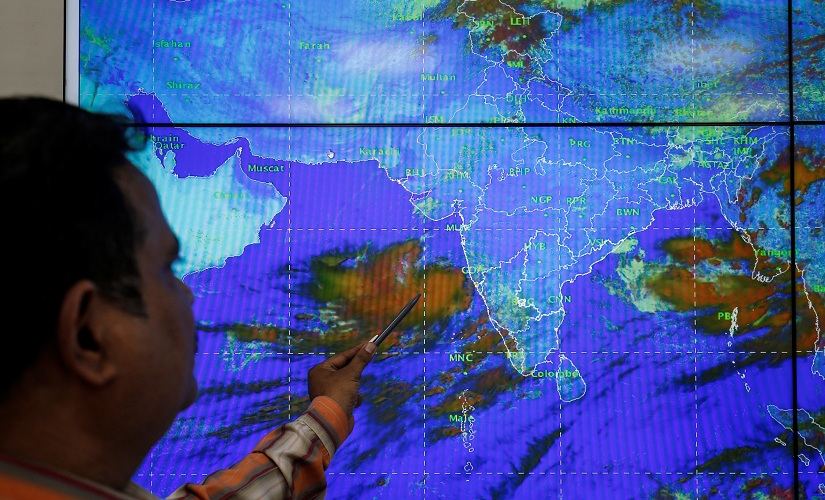The oceanic basin to the west of the Indian continent, which is generally not subjected to intense cyclonic activity, this year became a hotspot of sorts with a strong
Indian Ocean Dipole (IOD) and Madden Julian Oscillation (MJO) contributing to the Northeast Monsoon rains, particularly over the southern peninsular region. A strong IOD and MJO is responsible for the formation of successive Low-pressure Areas over the Bay of Bengal and the Arabian Sea. This year has recorded one of the
most active cyclone seasons in the North Indian Ocean with four major cyclonic storms formed off the coast of India in the Arabian Sea – Vayu, Fani, Kyarr and Maha.
Currently brewing in the Bay of Bengal is Cyclone Bulbul, which is likely to make a landfall in the states of Andhra Pradesh and Odisha. With this being the seventh cyclone of 2019 to affect India, weather forecasting agency Skymet in it latest bulletin said, “We are already on a par with 2018 when a record of seven cyclones was made. It is very likely that in 2019, we may surpass the number of 2018.” In 2018, the nation broke its 33-year record, after having been hit by seven cyclones. With there being 13 coastal states encompassing 84 coastal districts bearing the brunt of cyclones and four states – Andhra Pradesh, Odisha, Tamil Nadu and West Bengal and one Union Territory – Pondicherry on the East Coast being more prone to cyclonic disasters, let’s take a look at some of the most severe storms to have made landfall this year. Cyclone Fani, May: Severe cyclonic storm Fani made a landfall in Odisha and parts of West Bengal on 3 May, the first one to hit the nation.
The name “Fani”, meaning “hood of a snake” was given by Bangladesh. [caption id=“attachment_6561411” align=“alignnone” width=“825”] NASA image from 1 may, 2019, shows a satellite view of Cyclone Fani. AP[/caption] Causing severe damage in Odisha and crippling its economy, Fani left behind a trail of destruction killing over 40 people, uprooting trees and communication system. Cyclone Vayu, June: After the 1998 Gujarat cyclone, this year’s Vayu was the strongest tropical cyclone to affect the Saurashtra Peninsula in June. It was expected to hit the Gujarat coast between Porbandar and Mahuva with wind speeds up to 120 kmph on 13 June. [caption id=“attachment_6802911” align=“alignnone” width=“825”]
 An IMD scientist monitors Cyclone Vayu inside his office in Ahmedabad. Reuters[/caption] Despite not making landfall,
Vayu tracked close enough to the Indian coastline to produce minor impacts. Strong winds, heavy rainfall and large waves were experienced along large sections of the country’s western coast, particularly in Gujarat. Numerous thatched houses were either damaged or destroyed by gusty winds, with many kutcha houses having their roofs torn off. A large number of tin sheds were blown away, and many trees were uprooted along the Saurashtra coast and on the island of Diu. Cyclone Kyarr, October: After cyclone Gonu that ravaged the Oman coast in 2007,
Kyarr intensified to become the first Super Cyclonic storm in the Arabian Sea in the last 12 years in October. It has caused heavy rainfall in three states located on India’s west coast — Goa, Maharashtra and the north-coastal districts in Karnataka. [caption id=“attachment_7616821” align=“alignnone” width=“825”]
An IMD scientist monitors Cyclone Vayu inside his office in Ahmedabad. Reuters[/caption] Despite not making landfall,
Vayu tracked close enough to the Indian coastline to produce minor impacts. Strong winds, heavy rainfall and large waves were experienced along large sections of the country’s western coast, particularly in Gujarat. Numerous thatched houses were either damaged or destroyed by gusty winds, with many kutcha houses having their roofs torn off. A large number of tin sheds were blown away, and many trees were uprooted along the Saurashtra coast and on the island of Diu. Cyclone Kyarr, October: After cyclone Gonu that ravaged the Oman coast in 2007,
Kyarr intensified to become the first Super Cyclonic storm in the Arabian Sea in the last 12 years in October. It has caused heavy rainfall in three states located on India’s west coast — Goa, Maharashtra and the north-coastal districts in Karnataka. [caption id=“attachment_7616821” align=“alignnone” width=“825”] File image of Cyclone Kyarr. News18 Malayalam[/caption] According to the latest forecast, cyclone Kyarr was likely to continue its movement west-northwestwards towards Oman coast till 1 November. Cyclone Maha, November: The India Meteorological Department (IMD) on 4 November had predicted that Maha is likely to make landfall on Gujarat coast between Dwarka and Diu. The cyclone would take form of ‘severe to very severe storm’ while approaching the coast, resulting in severe winds gusting up to
100-120 kmph accompanied by heavy rainfall. [caption id=“attachment_7586931” align=“alignnone” width=“825”]
Latest satellite image of Cyclone Maha. Image Courtesy: IMD[/caption] However, the IMD predicted that the severe cyclonic storm Maha is
"very likely" to weaken into a depression by Thursday evening . In a bulletin released late on Wednesday night, the weather department said cyclone ‘Maha’ had moved east-northeastwards with a speed of 21 kmph and lay centred over east-central and adjoining northeast the Arabian Sea, about 250 km southwest of Porbandar in Gujarat and 290 km west-southwest of Diu.
In a bulletin released late on Wednesday night, the weather department said cyclone ‘Maha’ had moved east-northeastwards with a speed of 21 kmph and lay centred over east-central and adjoining northeast the Arabian Sea, about 250 km southwest of Porbandar in Gujarat and 290 km west-southwest of Diu.
Advertisement
End of Article


)

)
)
)
)
)
)
)
)



